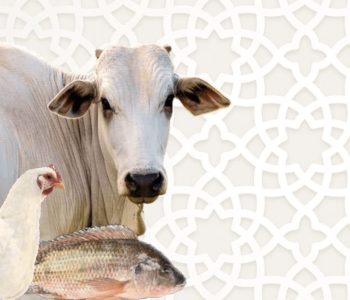Discover the Specifics of Halal Animal Nutrition
The IMF estimates that animal nutrition accounts for 5% of the global market, generating $500 billion annually with a 4% yearly growth rate.
Each Muslim-majority country either has an accrediting body that follows specific regulations or simply recognizes existing certifications. Therefore, companies must carefully consider their target markets, as they may need to comply with one or multiple Halal standards, which can vary slightly or significantly, depending on the applicable regulatory requirements.
This is the largest and fastest-growing market worldwide. Muslims make up over a quarter of the global population and have the highest average number of children per household compared to other religious groups. Additionally, the majority of consumers, including non-Muslims, recognize and demand the Halal seal on products due to its strong commercial influence.
Indeterminacy or doubt is referred to as Mashbooh (مشبوه), and according to Shariah, in cases of uncertainty, actions should not be taken, and products should not be consumed.
To be valid, it must be based on four fundamental principles:
I) Honesty: All resources used, processes carried out, materializations of descriptions, and business operations must be accurate and truthful.
II) Trust: It is essential to establish, implement, and maintain a Halal Management System (SGH) that is appropriate and effective.
III) Involvement: All employees must be engaged in obtaining Halal certification and act positively in support of the SGH.
IV) Documentation: Plan, create, complete, and maintain records that verify Halal-compliant production processes and products.
The SGH is commonly structured into 11 key points that organizations must understand, discuss, design, implement, monitor, review, maintain, and continuously improve.
1. Halal Policy:
2. Halal Committee:
Appointed by senior management, the Halal Committee is responsible for overseeing critical activities related to Halal certification. Its members must have clearly defined roles and responsibilities, ensuring compliance with Halal standards. All activities, including meeting objectives, must be duly recorded, with regular and competent meetings held to maintain and improve the Halal Management System (SGH).
3. Halal Training:
It is recommended to conduct an external Halal training covering specific requirements, followed by annual internal training sessions to reinforce knowledge. The effectiveness of this training must be documented and verified to ensure proper application of Halal standards.
4. Halal Verification:
In addition to lawfulness (“halalness”) in business dealings, relationships, and marketing, companies must verify Halal compliance at every stage, including the origin, procurement, and processing of ingredients, raw materials, additives, inputs, accessories, sanitizers, lubricants, and productions. For certain ingredients, Halal certification from the source is mandatory, while others may only require a critical Halal approval analysis for validation.
a) Animal origin from slaughter: It may be mandatory to request and present a valid Halal certification issued by a recognized certifying body.
b) Animal origin not from slaughter: It is recommended to obtain Halal certification or conduct a thorough approval analysis of suppliers.
c) Plant, microorganism, synthetic, or semi-synthetic origin: Halal certification is optional, as long as its usage restrictions are respected, such as structural modifications, pre-processing, etc., and the ingredients are not illegally acquired or used.
5.Halal Identification and Segregation:
Commercial names, misleading labels, and packaging that are not in compliance with Shariah are prohibited. It is mandatory to segregate products according to Halal standards to ensure full compliance.
6. Halal Production:
7. Critical Halal Analysis:
A written procedure that demonstrates the company has conducted a thorough analysis of anything that could alter the Halal status of its products, including a risk matrix for food and legal actions to protect customers from potential failures or violations. This procedure should ensure full compliance with Halal standards and address both technical and legal aspects to safeguard the integrity of the products.
8. Traceability:
A control mechanism capable of tracking every component of Halal products from their origin to the batches shipped to customers, regardless of the methodology used. This system ensures full traceability and accountability at every stage, guaranteeing that all products remain compliant with Halal standards throughout the supply chain.
9.Non-compliant Products:
Products that do not meet Halal compliance requirements must be treated as non-Halal rejects. Immediate corrective actions must be taken, such as reclassification, repair, or reworking based on appropriate corrective actions and verifications. It is mandatory for a crisis committee to conduct at least one recall exercise to ensure the integrity of Halal products and to prevent any non-compliant products from reaching the market.
10. Internal Halal Audit:
The internal Halal audit should be conducted comprehensively at least once a year by competent personnel with Halal knowledge. The audit criteria must align with ISO 19011 (guidelines for auditing management systems) and the Halal scheme of the certifying body. The audit results must be documented in a report, which may include responses to the action plan to address any identified issues and ensure ongoing compliance with Halal standards.
11. Halal Evaluation:
The top management must monitor all results and hold annual meetings with the Halal committee to provide feedback and review protocols and documents. This ensures the Halal status within the company is maintained and supports continuous improvement of Halal practices, aligning with both technical and religious requirements.
• Broiler chickens for the Arab Gulf market, in the last three days before slaughter, must be fed exclusively green feed. PET feed packaging must comply with Shariah requirements, as well as the marketing and commercialization of all types of animal feeds.
Read original article in portuguese at nutriBrasil.com
By: Yuri de Gennaro Jaruche | Technical Auditor CDIAL Halal – Certification Authority.
